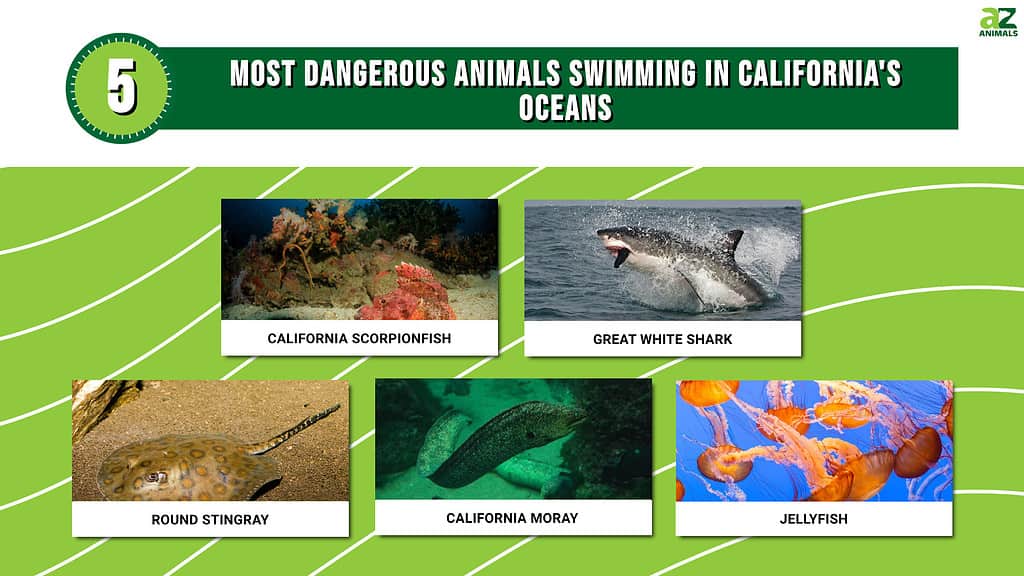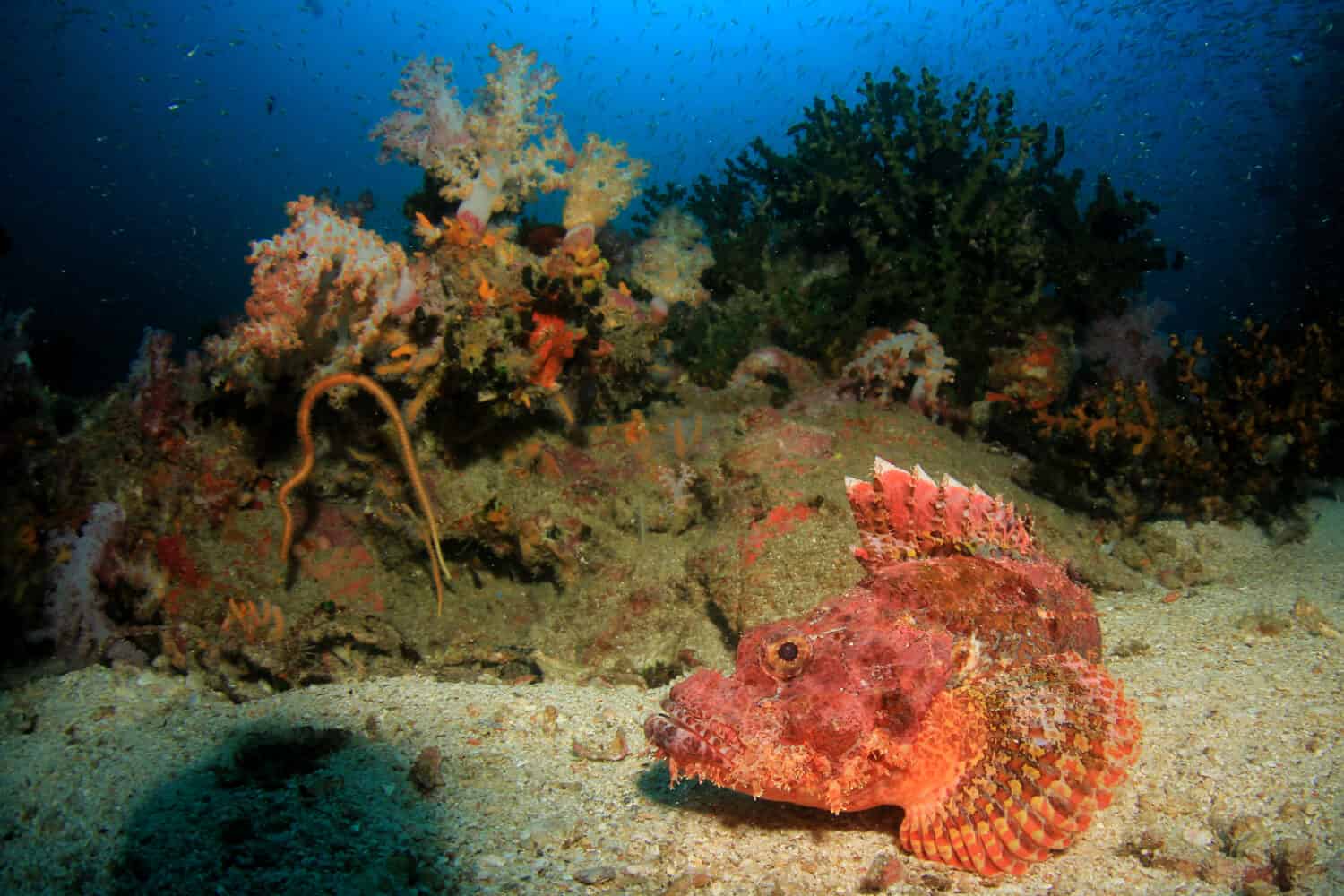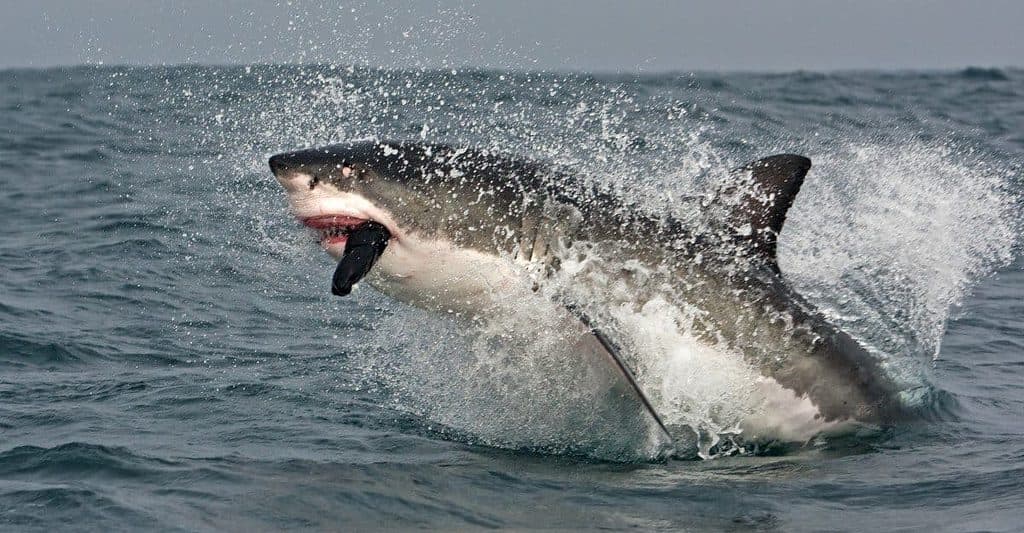
California supports one of the most diverse arrays of animals found anywhere in the United States. While most of the creatures in California are harmless, you can find numerous dangerous animals across the state. Whether you’re visiting its rivers or lakes, or hiking through its wild terrain, California is home to numerous deadly beasts. Similarly, the coasts of California teem with a wide variety of dangerous marine animals. Here are the 5 most dangerous animals swimming in California’s oceans.
5. California Scorpionfish

California scorpionfish produce potent venom that can cause pain similar to a
rattlesnake
bite.
©Rich Carey/Shutterstock.com
Scorpaena guttata is more commonly known as the California scorpionfish. It belongs to the scorpionfish family Scorpaenidae, which includes several of the world’s most venomous species. As its name implies, you can find California scorpionfish across the coast of California. Their range extends from Santa Cruz to Baja California. They mostly live in underwater caves in bays or along rocky bottoms just offshore.
California scorpionfish can grow up to 19 inches long. They appear reddish-brown on the back and fins and possess a whitish belly. Numerous black and brown spots dot their fins and body. Several venomous spines run along the head and back.
Experienced California fishers are well aware of the danger posed by California scorpionfish. Anglers frequently get stung when trying to remove California scorpionfish from their lines. In addition to being sharp, the spines of a California scorpionfish possess potent venom. The venom causes severe pain similar to a rattlesnake bite. Other symptoms can include rashes or redness, swelling, nausea, fatigue, or allergic reactions.
4. Great White Shark

The great white shark has been responsible for over 180 attacks off the coast of California since 1950.
©Martin Prochazkacz/Shutterstock.com
The notorious great white shark (Carcharodon carcharias) is one of the most dangerous animals swimming in California’s oceans. This large species of mackerel shark lives in epipelagic and coastal waters all around the world, including off the coast of California. Great white sharks can dive to depths of up to 3,900 feet below the surface. However, they also spend a great deal of time in more shallow waters.
Great white sharks display sexual dimorphism, with females measuring larger than males. On average, males measure 11 to 13 feet long, while females measure 15 to 16 feet long. That said, exceptionally large specimens can measure around 20 feet long and weigh over 4,000 pounds. The upper half of the body appears gray while the bottom appears white. They have large, powerful bodies, conical snouts, and a distinctive triangular dorsal fin.
Great white sharks are equipped with over 300 razor-sharp teeth arranged in several rows. They possess one of the strongest bite forces of any animal at 4,000 pounds per square inch. As apex predators, great white sharks are used to tackling some of the largest creatures in the ocean. While they do not typically see humans as prey, they will occasionally attack people.
There have been around 204 recorded shark attacks off the coast of California since 1950. Of these attacks, over 180 – around 90% – involved great white sharks. Most attacks happen when great white sharks mistake surfers or divers for prey. Thankfully, only a small number of these attacks (15) resulted in fatalities.
3. Round Stingray

Round stingrays rarely sting but when they do they can deliver a painful jab.
©iliuta goean/Shutterstock.com
The round stingray (Urobatis helleri) also goes by the name the little round stingray or Haller’s round ray. A member of the round ray family Urotrygonidae, you can find round stingrays all along the coast of California. They inhabit tropical and subtropical waters close to shore and rarely occur below 50 feet. That said, they can live at depths up to 300 feet below sea level.
As its name implies, the round stingray features an almost perfectly round pectoral fin disc. This disk looks gray or brown from above and white or yellow on the ventral side. The dorsal side of the disc sports numerous yellow spots. Males and females vary in size, with females typically measuring larger than males. Males usually measure around 10 inches in diameter while females can measure over 12 inches in diameter. Like all stingrays, they possess tails that end in a long, stinging spine.
Round stingrays prefer shallow sandy or muddy habitats near shore where they hunt for mollusks, crabs, and worms. As a result, they often come into contact with people wading in the water. When disturbed, the stingrays will lash out with the sharp spine located on the end of their tails. While usually not dangerous to humans, their spine can inflict a painful sting. Symptoms include pain, weakness, nausea, and anxiety. Lifeguards often keep hot water on hand to treat such stings, as the hot water helps to reduce the pain and neutralize the stingray venom.
Many incidents with round stingrays in California occur near the northern end of Seal Beach in an area known as “Ray Bay.” The nearby Edison Plant warms the water in the area and attracts stingrays. To avoid getting stung by a stingray, try shuffling your feet when wading near shore. This shuffling motion will alert stingrays of your presence and reduce the chances of you stepping on resting round stingrays.
2. California Moray

The California moray’s bite can produce a nasty infection and leave deep puncture wounds.
©SunflowerMomma/Shutterstock.com
The California moray (Gymnothorax mordax) belongs to the moray eel family Muraenidae. It represents the only member of its family found off the coast of California. You can find them from Santa Barbara to Baja California. California morays typically live in rocky reefs and similar habitats up to 120 feet deep. However, juvenile California morays may also inhabit tide pools along the shore.
At full size, California morays can measure up to 5 feet long. In terms of color, most specimens appear greenish brown. They possess small eyes, strong jaws, and tubular nostrils. Like other moray eels, they do not possess pelvic or pectoral fins or gill covers. Their lack of such features as well as scales allows them to quickly navigate rocky crevices.
California morays are apex predators that primarily hunt at night. Their diet consists mostly of octopuses, lobsters, shrimp, and other morays. As such, they rarely attack humans unless surprised or threatened. While not normally dangerous to humans, California morays are still one of the more dangerous animals swimming in California’s oceans. They can inflict a painful bite with their powerful jaws and sharp teeth capable of causing deep wounds. Additionally, their bites can cause secondary infections, which may prove fatal if left untreated.
1. Jellyfish

California is home to numerous stinging jellyfish such as the black sea nettle.
©Ken Wolter/Shutterstock.com
Also known as sea jellies, jellyfish are a common sight all across the coastline of California. You can find numerous jellyfish species in California, including purple-striped jellies (Pelagia noctiuluca), black sea nettles (Chrysaora achlyos), and moon jellyfish (Aurelia aurita). Other species, such as the lion’s mane jelly (Cyanea capillata) occur only rarely off the California coast.
Jellyfish in California vary in size and color depending on the species. For example, moon jellyfish measure around 10 to 16 inches in diameter, while black sea nettles can measure 3 feet in diameter and have arms up to 20 feet long. California jellyfish also vary wildly in color, with lion’s mane’s jellyfish looking mostly orangish-red, purple-striped jellyfish appearing purple, pink, or light brown, and moon jellyfish looking mostly translucent.
Jellyfish use their stingers to stun or kill small aquatic animals. Of the dangerous animals swimming in California’s oceans, jellyfish rank as one of the least deadly, as their stings are normally not fatal to humans. However, their stings can still cause a significant amount of pain, as well as skin rashes, fever, and muscle cramps. In some individuals, jellyfish stings can also cause an allergic reaction, which may require medical treatment.
Summary of the 5 Most Dangerous Animals Swimming in California’s Oceans
| Rank | Animal | Danger |
|---|---|---|
| 1 | Jellyfish | Stings can cause allergic reactions, significant pain, skin rashes, fever, and muscle cramps |
| 2 | California Moray | Painful bites can cause deep wounds that can cause infection |
| 3 | Round Stingray | Spine can inflict a painful sting with symptoms that include pain, weakness, nausea, and anxiety |
| 4 | Great White Shark | While rare, shark attacks can produce deep wounds and death |
| 5 | California Scorpionfish | Venomous bites cause severe pain, rashes or redness, swelling, nausea, fatigue, or allergic reactions |
Thank you for reading! Have some feedback for us? Contact the AZ Animals editorial team.








